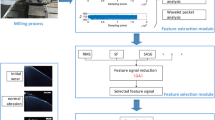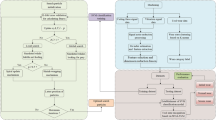Abstract
This paper presents a multi-sensor information fusion method for tool condition monitoring (TCM) using acoustic emission and cutting sound as monitoring signals. In order to make the cutting state in experiments closer to that in actual production, the traditional data acquisition method was improved. Using time–frequency analysis methods and multi-fractal theories, each kind of signal was filtered and their features were extracted according to characteristics respectively. The decision level fusion method was used for realizing information fusion by the model of support vector machines (SVMs) ensemble. Its base layer composes of two models of SVMs for regression (SVRs). Before training, the two SVRs were optimized by multiple population genetic algorithm including input features selection and model parameters optimization. Its decision layer is a model of SVM for classification or SVR, which is used for the combined decision according to the sub-decisions of SVRs in the base layer. The test results of SVMs ensemble show that the method can be used effectively for classification of tool wear condition and prediction of tool wear quantity. It can make information of the two sensors complement each other and is better than methods using a single sensor for TCM.
























Similar content being viewed by others
References
Agustin, G., Rodolfo, H., Rauldel, T., Pastora, V., & Andres, B. (2012). Tool wear monitoring using neuro-fuzzy techniques: A comparative study in a turning process. Journal of Intelligent Manufacturing, 23, 869–882.
Ai, C. S., Sun, Y. J., & He, G. W. (2012). The milling tool wear monitoring using the acoustic spectrum. International Journal of Advanced Manufacturing Technology, 61, 457–463.
Bahador, K., Alaa, K., Fakhreddine, O. K., & Saiedeh, N. R. (2013). Multisensor data fusion: A review of the state-of-the-art. Information Fusion, 14, 28–44.
Bhaskaran, J., Murugan, M., Balashanmugam, N., & Chellamalai, M. (2012). Monitoring of hard turning using acoustic emission signal. Journal of Mechanical Science and Technology, 26(2), 609–615.
Chen, J. C. (2000). An effective fuzzy-nets training scheme for monitoring tool breakage. Journal of Intelligent Manufacturing, 11, 85–101.
Danko, B., Dubravko, M., Toma, U., & Josip, K. (2012). Tool wear estimation using an analytic fuzzy classifier and support vector machines. Journal of Intelligent Manufacturing, 23, 797–809.
Federico, P., Alberto, P., Giorgio, P., & Fergal, D. (2010). Analysis of metal cutting acoustic emissions by time series models. International Journal of Advanced Manufacturing Technology, 48, 897–903.
Holland, J. H. (1975). Adaptation in natural and artificial systems. Ann Arbor: The University of Michigan Press.
Hsueh, Y. W., & Yang, C. Y. (2008). Prediction of tool breakage in face milling using support vector machine. International Journal of Advanced Manufacturing Technology, 37, 872–880.
Huang, N. E., Shen, Z., & Long, S. R. (1998). The empirical mode decomposition and the Hilbert spectrum for nonlinear and non-stationary time series analysis. Proceedings of the Royal Society A, 454, 903–995.
Jemielniak, K., Kwiatkowski, L., & Wrzosek, P. (1998). Diagnosis of tool wear based on cutting forces and acoustic emission measures as inputs to a neural network. Journal of Intelligent Manufacturing, 9, 447–455.
Jose, V. A., & Fernando, R. S. (2010). A review of machining monitoring systems based on artificial intelligence process models. International Journal of Advanced Manufacturing Technology, 47, 237–257.
Li, B., Zhang, P. L., & Wang, Z. J. (2012). Morphological covering based generalized dimension for gear fault diagnosis. Nonlinear Dynamics, 67, 2561–2571.
Lou, X. N., & Lin, C. J. (1997). An intelligent sensor fusion system for tool monitoring on a machining centre. International Journal of Advanced Manufacturing Technology, 13, 556–565.
Mohammad, M., Simon, S. P., & Martin, B. G. J. (2009). Tool wear monitoring of micro-milling operations. Journal of Materials Processing Technology, 209, 4903–4914.
Olsen, L. (2005). Mixed generalized dimensions of self-similar measures. Journal of Mathematical Analysis and Applications, 306, 516–539.
Pitsikalis, V., & Maragos, P. (2009). Analysis and classification of speech signals by generalized fractal dimension features. Speech Communication, 51, 1206–1223.
Rafezi, H., Behzad, M., & Akbari, J. (2012). Time domain and frequency spectrum analysis of sound signal for drill wear detection. International Journal of Computer and Electrical Engineering, 4(5), 722–725.
Rehorn, A. G., Jin, J., & Orban, P. E. (2005). State-of-the-art methods and results in tool condition monitoring: A review. International Journal of Advanced Manufacturing Technology, 26, 693–710.
Segeto, T., Simeone, A., & Teti, R. (2013). Multiple sensor monitoring in nickel alloy turning for tool wear assessment via sensor fusion. Procedia CIRP, 12, 85–90.
Sharma, V. S., Sharma, S. K., & Sharma, A. K. (2008). Cutting tool wear estimation for turning. Joural of Intelligent Manufacturing, 19, 99–108.
Srinivasa Pai, P., & Ramakrishna Rao, P. K. (2002). Acoustic emission analysis for tool wear monitoring in face milling. International Journal of Production Research, 40(5), 1081–1093.
Trabelsi, H., & Kannatey-Asibu, E, Jr. (1991). Pattern-recognition analysis of sound radiation in metal cutting. International Journal of Advanced Manufacturing Technology, 6, 220–231.
Vapnik, V. N. (1995). The nature of statistical learning theory. New York: Springer.
Acknowledgments
This work was supported by the Project of National Natural Science Foundation under Grant No. 51275081, the Key Project of National Natural Science Foundation under Grant No. 51335003, the Major Special Projects in the Scientific Innovation of Liaoning Province under Grant No. 201303004, and the Project of High-tech Industry Development and Tackling Key Plan of Science and Technology under Grant No. F13-01-21-00.
Conflict of interest
The authors declare that they have no conflict of interest.
Author information
Authors and Affiliations
Corresponding author
Rights and permissions
About this article
Cite this article
Zhang, Kf., Yuan, Hq. & Nie, P. A method for tool condition monitoring based on sensor fusion. J Intell Manuf 26, 1011–1026 (2015). https://doi.org/10.1007/s10845-015-1112-y
Received:
Accepted:
Published:
Issue Date:
DOI: https://doi.org/10.1007/s10845-015-1112-y




